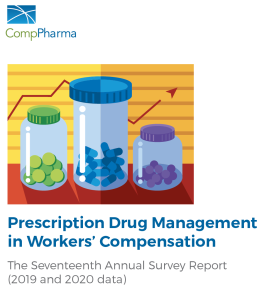is pretty good.

Here are the very preliminary takeaways from the latest Survey of Prescription Drug Management in Workers’ Comp...so far 21 phone interviews completed and several more still to go.
[if you’re new to MCM, we’ve done an annual Survey since 2004, past public reports are here (respondents get a much more detailed version)]
- Drug spend continues to decline, although at first blush it looks like the drop is less than we’ve seen in recent years
- Opioid spend is also continuing its downward trend
- Generic efficiency – the percentage of scripts that could be filled with generics that are filled with generics – is just shy of 100%
- Payers are still struggling with legacy opioid patients with respondents identifying patient resistance (mostly fear driven), recalcitrant prescribers, attorneys and the lack of regulatory/legislative support as key obstacles
- Physician dispensing is once again rearing its ugly/profiteering/self-serving/taxpayer-abusing head.
- Payers want more transparency while fully understanding PBMs need to make a profit.
- Topicals seem to be the latest in the scam-a-rama that is the physician dispensing industry.
- Respondents are generally very open to non-pharmaceutical approaches to pain management – much more on this in a future post.
What does this mean for you?
PBMs and payers – well done. Your work has saved countless lives while helping countless others regain control of theirs.



Thanks, Joe. Related to legacy OPR patients and their fear avoidance beliefs, working in the substance use disorder field for a while now, I’ve seen some approaches that work well, especially in cases of iatrogenc Opioid Use Disorder. Taking a non-judgmental stance. Asking open-ended questions. Stating objective, evidence-based concerns about use patterns/behavior. Assessing readiness to change, and aligning recommendations with patient’s flexibility tolerance. In combination with UDS monitoring and patient agreement/contracting, when appropriate. Patients with a confirmed “addiction” diagnosis (latest data from SAMHSA tells us it’s anywhere from ~3-19% of pain patients) require a different level of clinical expertise and set of interventions, but strengths-based, care-first approach works. I learned 30 years ago: gain trust first, establish rapport, build an alliance that levels out the power differential between patient-provider as much as possible/realistic, and consider that FEAR (to your point) not necessarily aberrant behavior/drug-seeking motives, is often the key driver to change resistance. Obviously, the prescribers, attorneys, and regualtory issues are other matters altogether.
Thanks David. Appreciate you sharing your views and expertise.
Be well Joe